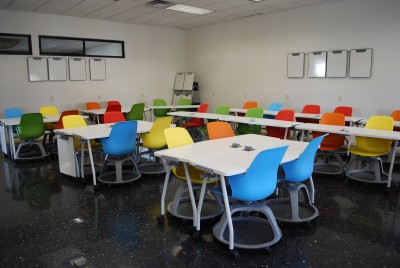Covid Package of Measures for a Successful Start of the School Year 2021/22
Children and young adults, who have already had to do without many things in the past two years, are starting the new school year with a safety concept that is based on four pillars. Large-scale school closures and shift teaching are no longer an option in the new school year. But what will attendance look like in the new school year?
 4-point plan for a safe start to school in the fall. / Picture: © Wikimedia Commons / Thelmadatter, CC BY-SA 3.0
4-point plan for a safe start to school in the fall. / Picture: © Wikimedia Commons / Thelmadatter, CC BY-SA 3.0
Children and teens are a priority now. They have done without a lot in recent years. Attendance is to be continuous in the new school year, even though the Corona pandemic will continue to be with us. Large-scale school closures and shift teaching are no longer an option in the new school year. To ensure that this can succeed, the schools are starting the fall with a safety concept based on four pillars.
1) Early warning system for schools and elementary education facilities
Wastewater analysts will help keep a close eye on the risk situation and be able to react at an early stage. In cooperation with the Vienna University of Technology and the University of Innsbruck, these are carried out on an ongoing basis at 116 wastewater treatment plants throughout the country (see map). This means that around 75% of students and 3,062 school locations are covered. The wastewater analysis can detect the virus about seven days before the infections are first detected. In the event of an increased risk situation, the schools and elementary educational institutions in the municipality or region are warned at an early stage and can react regionally (tests, masks) before the infections spread. Austria is an international pioneer with this procedure in the education sector, as it was with the nationwide use of anterio-nasal rapid testing.
The second pillar of the early warning system is regular PCR testing at around 300 schools. The gargle study will be continued, but the results will be delivered much faster. If these show an increasing risk, individual tests are carried out with all pupils. Infected individuals can thus be quickly identified.
2) PCR and antigen testing at all schools
Beginning in the fall, students will perform PCR testing at all school sites nationwide. Testing at the schools will occur three times a week, and at least one of the tests will be a PCR test. Students perform the PCR tests in the classroom. The solution is rinsed in the mouth (not gargled) to avoid aerosol formation. Motto: "Everything rinses." The PCR tests are coded, no personal data is provided to the laboratories. In the laboratories, the samples are evaluated in pooled form. Only in the positive case, individual samples are analyzed and the codes of the positive samples are reported to the health authorities. The assignment of the code to the name is done in the school.
In order to get a quick result, antigen tests will continue to be used, which have already been applied in the summer semester 2021. The tests are well established, well received by students, and are an effective pandemic response tool. The additional blanket PCR testing in schools is unique by international standards. The tests are recorded in the Ninja Pass, which allows access to sports clubs, restaurants, hairdressers, etc. during free time.
3) Vaccination buses travel to schools
Students 12 years and older have the opportunity to be vaccinated. Vaccination is the best condition for stable school operation. In order to offer the vaccination vaccination, vaccination buses will travel to school locations. The campaign will start in some states with around 30 vaccination buses already during summer school in the last two weeks of vacation. Students who want to be vaccinated can easily take advantage of the offer in a vaccination bus and thus protect themselves and their classmates.
Vaccinated students are exempt from mandatory testing after the safety period during the first two weeks of school (see below). On a voluntary basis, students may continue to participate in testing.
4) Air filter
Where ventilation is not possible or is very difficult, air purification devices are used. The federal government subsidizes the purchase of these devices by school owners. Up to 10 million euros are available for this purpose. The Federal Procurement Agency (BBG) selects suitable devices. Air purification devices do not replace vaccination or testing. They are a supplementary measure to the existing hygiene concept. New school buildings receive mechanical supply and exhaust systems for each class to improve air quality in classrooms. Funds from the school development plan (SCHEP) will be used for this purpose. An air cleaning device shall not exceed 47 dB(A) and shall have H13 or H14 class filters. The use of UV filter devices is to be avoided, as these generate ozone in the room air.
Safety phase in the first two weeks of school
During the first two weeks of school, all students are tested three times, even if they have already been vaccinated. During this safety phase, everyone also wears a mask outside the classrooms. Unvaccinated teachers also wear the mask in the classroom. Whether masks must continue to be worn after the safety phase and large-scale testing must continue depends on the general risk situation.
BMBWF - Ministry of Education - Bundesministerium fuer Bildung Wissenschaft und Forschung



